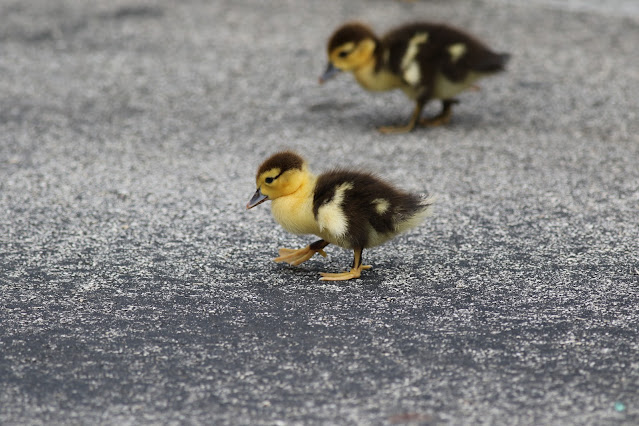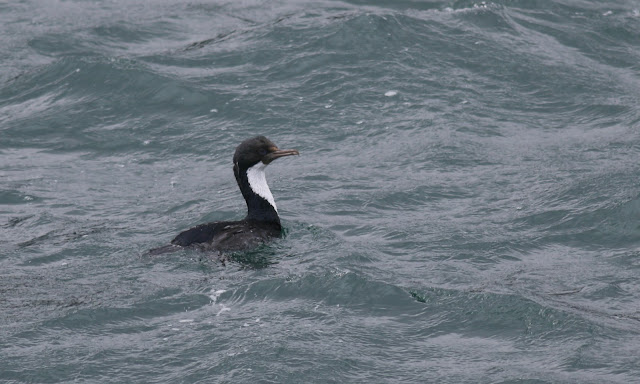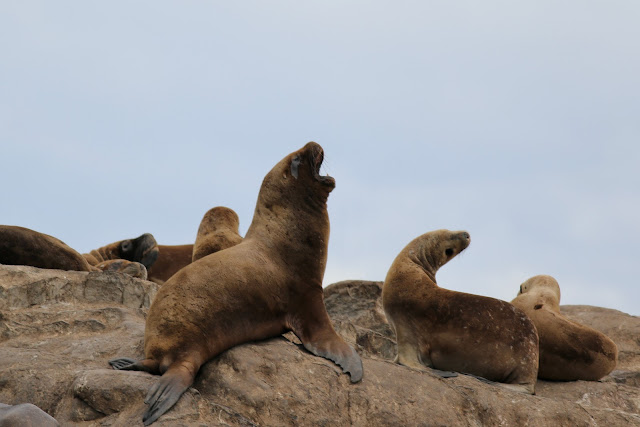Apologies for the long wait since last post! I have been quite busy with about a million photos to curate from my recent trip to Antarctica! The official trip with Lindblad started in Miami where we entered the "bubble" which was the Blue Lagoon Hotel at Miami airport. The idea of the bubble was to get tested for COVID before our flight and then stay with our group exclusively for the next couple weeks as we traveled to and from Antarctica. This was after a very stressful period of waiting for my PCR COVID test in Wilmington and was one of the 4 COVID tests I would have while on this vacation. Luckily everything went well and as far as I can tell, I still have never contracted it, knock on wood.
While we waited for our flight, I walked around the hotel grounds and picked up the usual Florida species including the now countable Muscovy Ducks.
Muscovy Duck with chicks.
The hotel did it's best to prime the pump of non-stop food I was to eat over the next two weeks. For those that know me, I never turn down a free meal and that includes meals that are part of a package. That is why I don't like package deals, I usually gain weight.
The flight was a non-stop red-eye charter flight from Miami to Ushuaia in Argentina. I tried to get some sleep but its hard to sleep sitting up with my knees scrunched in front of me especially with my history of pulmonary emboli weighing on my mind. So when we arrived at Ushuaia airport and were promptly herded into buses for our first foray into this beautiful landscape of Terra Del Fuego, I was a little delirious and the next half day was spent in a blur. I am happy I took tons of photos so I can relive it on more sleep.
The buses took us into the heart of Terra Del Fuego National Park which is just adjacent to Ushuaia for a planned cruise on a catamaran in the park through the Beagle Channel to our awaiting ship, the National Geographic Explorer. I thought maybe the trip into the park would rekindle some memories as my family had traveled in Argentina when I was just a little boy, but it all looked new to me.
Matthew and I were already trying to pick up birds from the bus, hoping to catch a glimpse of the Magellanic Woodpecker, the iconic largest woodpecker in the Americas and one of the remaining species in the same family as the Ivory-billed - Campephilus.
Spoiler-alert - we didn't see one. However, we did get our first looks at the Upland Goose and the bus driver even stopped so we could snap some photos from inside the bus.
Upland Goose female - like many of the species we saw on the trip, they are only seen in southern Chile and Argentina and also the Falkland Islands. There is a similar species called Ruddy-headed Goose which looks similar to the female Uplands, but we never got on them.
The male cannot be confused with any other species.
Matt and I knew that we would have very little time on land so we did our best to try and find some land birds but it was tough as they led us to the catamaran docking location with only a few species seen.
The end of the world, Terra Del Fuego was named Land of Fire by the Spaniards due to the volcanic nature of the archipelago which straddles both Chile on one side and Argentina on the other. The Beagle Channel is the body of water that acts like a dividing line between the two countries and that is where we started our adventure.
The view form the catamaran.
Matt grinning ear to ear with all the new possibilities of birds floating through his sleep deprived head.
Kelp Gulls ended up being the most common gull of the trip and the only true gull we saw once we made it across the Drake Passage.
Matt spotted these Flightless Steamer-ducks in a bay near our mooring site. With a Dolphin Gull in the foreground for size comparison, you can see these are big ducks! Not sure what makes a duck into a goose, but these guys seem to fit the bill, pardon the pun. They sit deep in the water and seem to have the ability to immerse themselves much like our Pied-billed Grebe and Anhinga can.
A soaring Black-chested Buzzard-eagle fly-by was the only one of the trip.
Steamer-duck in better light.
I wasn't expecting a Rufous-collared Sparrow which is the same species I have seen at high elevation in Costa Rica.
This Buff-winged Cinclodes was our first Cinclodes species for the trip and was seen on the rocks right next to our boat while we waited to push off.
Once the boat pushed off the mooring, most people on the trip went in for a luxury meal. Matt and I couldn't peel ourselves away from the deck and potential lifers so we skipped the meal.
Here is a Flightless Steamer-duck showing its Lochness Monster mode.
In the distance we spotted our first Kelp Geese which are about as close to an endemic that the region gets. The male is a striking white that camera sensors don't like and the female is dark. Racial unity! I love it.
It was hard to concentrate on the birds with all the gorgeous scenery.
 Kelp Gull
Kelp GullImperial Cormorant - which may or may not be split out into multiple species in the near future. These were everywhere and probably the most common species. Other names include Blue-eyed Shag or Imperial Shag.
South American Terns look a lot like Arctic Terns which also can be in this area but they have flipped plumages. The South American Tern is snazzy during the austral summer which is our winter, whereas the Arctic Terns would be in non-breeding plumage.
Black-browed Albatross - I knew I would be seeing lots of these but I was unprepared for the sheer numbers, even in the Beagle Channel which is not a massive waterway.
Chilean Skua - These are pretty much the default Skua in the Beagle although there are plenty of reports of South Polar Skua too.
The other name for it is Cinnamon Skua due to the warmer reddish tones but also the cap is usually more defined than on other Skuas.
Here you can see better the cinnamon throat and defined cap.
As we neared Ushuaia harbor, we stopped at some islets with breeding colonies of the common species in the area.
As we entered the harbor of Ushuaia! This is where we would switch to our ship for the rest of the trip - the National Geographic Explorer.


























































No comments:
Post a Comment